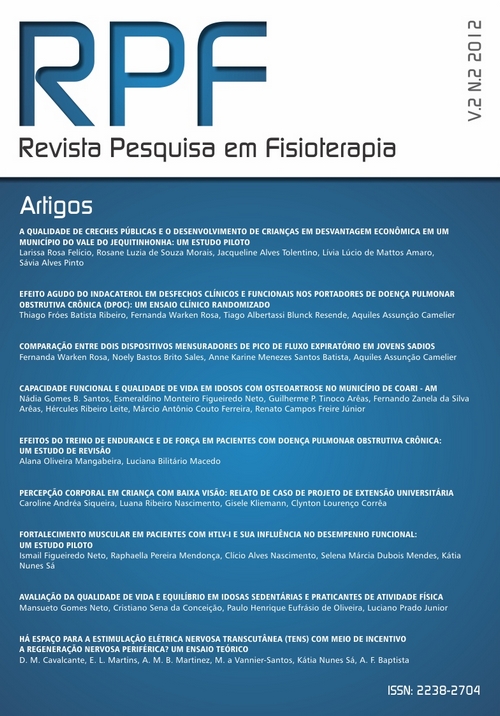HÁ ESPAÇO PARA A ESTIMULAÇÃO ELÉTRICA NERVOSA TRANSCUTÂNEA (TENS) COM MEIO DE INCENTIVO A REGENERAÇÃO NERVOSA PERIFÉRICA? UM ENSAIO TEÓRICO
DOI:
https://doi.org/10.17267/2238-2704rpf.v2i2.99Abstract
Introduction: The use of electromagnetic fields in order to promote peripheral nerve regeneration has been studied mainly from the 80s. Many ways of delivering electric fields were used, such as implanted electrodes, intraoperative stimulation and needle electrodes, but there are few data on the use of electrical stimulation with surface electrodes (transcutaneous). On the other hand this form is often used for pain control, and in some associated conditions, there is peripheral nerve injury and associated Waleriana degeneration. Objectives: The aim of this paper is to present ways of using electric fields clinically with the goal to promote peripheral nerve regeneration and discuss within this surrounding context, the use of transcutaneous electrical nerve stimulation. Methods: We performed a narrative review of the literature, including pre-clinical and clinical studies on the use of electric fields to promote peripheral nerve regeneration, which have been published in journals indexed in PubMed and SciELO, in Portuguese, English, French and spanish , from 1980 until 2012. Results and Discussion: The vast majority of studies found were preclinical in mice and rats. The perioperative stimulation with implanted electrodes is the most common form of stimulation, and only one used the transcutaneous electrical nerve stimulation. In general the results indicate a positive effect on peripheral nerve regeneration, but the stimulation parameters appear to be critical to the results, especially the frequency of the current, the period of initiation of treatment and the number of stimulation sessions.Downloads
Download data is not yet available.
Downloads
Published
01/23/2013
Issue
Section
Literature Reviews
How to Cite
1.
Cavalcante DM, Martins EL, M. B. Martinez A, Vannier-Santos M a, Nunes Sá K, F. Baptista A. HÁ ESPAÇO PARA A ESTIMULAÇÃO ELÉTRICA NERVOSA TRANSCUTÂNEA (TENS) COM MEIO DE INCENTIVO A REGENERAÇÃO NERVOSA PERIFÉRICA? UM ENSAIO TEÓRICO. Rev Pesq Fisio [Internet]. 2013 Jan. 23 [cited 2024 Nov. 23];2(2). Available from: https://www5.bahiana.edu.br/index.php/fisioterapia/article/view/99



